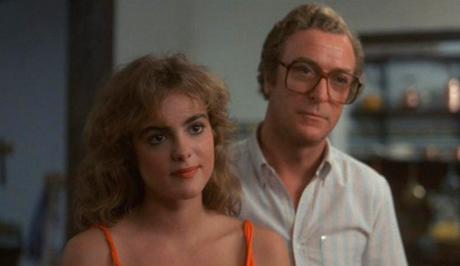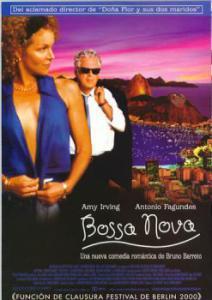Doing the Bossa Nova
 Pedro Paulo (Antonio Fagundes) & Mary Ann (Amy Irving) in Bossa Nova
Pedro Paulo (Antonio Fagundes) & Mary Ann (Amy Irving) in Bossa Nova
While Walter Salles’ Central Station attempts to bind up old wounds from Brazil’s past with expectations of a brighter future, Bruno Barreto’s Bossa Nova (1999) takes a step backward towards an altogether different set of standards. There’s no point in making a side-by-side comparison of the two pictures, although if one were attempted it would be the equivalent of pitting, say, Mark Hellinger’s documentary-style The Naked City against Hope and Crosby’s farcical Road to Rio — both flicks from the same late-forties time period.
Adapted from the 1989 novel A Senhorita Simpson by carioca writer Sérgio Sant’Anna, Bossa Nova (a Woody Allen-like romantic comedy, by most descriptions) stars the director’s spouse, Amy Irving, as the widowed Mary Ann Simpson, a forty-something former airline hostess-turned-English language instructor; and Rio-born leading man Antonio Fagundes as Pedro Paulo Silva, a middle-aged lawyer who finds the still fetching Miss Simpson worth pursuing (don’t we all?) during the course of its long-winded plot.
The other cast members, most of whom have worked together in diverse capacities throughout the years, include Drica Moraes as Mary Ann’s friend and assistant Nadine; Alexandre Borges as Acácio, a girl-crazy soccer player who frets about his recent trade to a British club; Débora Bloch as Tania, Pedro Paulo’s wife of seven years who recently left him for a Chinese tai-chi practitioner; Pedro Cardoso as Roberto, Pedro Paulo’s lovesick brother who hankers after the law firm’s new intern; Giovanna Antonelli as Sharon, the new intern who only has eyes for the soccer player; Kátia Lyra as the English school’s one-track-minded receptionist; and Stephen Tobolowsky as Gary/Trevor, a nerdy American corporate type who strikes Nadine’s fancy via an online dating service.
You can imagine the endless combination of circumstances this mixed-up group of individuals gets into! Here’s a tiny sampling: still smarting from his wife’s separation, Pedro Paulo has a meet-cute with Miss Simpson; in fact, they share an elevator ride to the English school where she teaches. Naturally, he’s immediately taken with the tutor, so he signs up for nightly classes as a pretext for getting to know her better (his master-tailor father just happens to have an office in the same building as the school).
Pedro Paulo is but one of numerous of complications Mary Ann has to contend with, among them that over-sexed soccer player who wants more than private lessons from her. His prankish efforts at turning Brazilian expletives into their English equivalent (“Go to shit!” and “Kiss it, my ass!”) are nothing short of strained.

Billed as a “love letter to Rio” — and a perfect Valentine’s gift to his wife — Barreto’s Bossa Nova was produced by his parents, Lucy and Luiz Carlos Barreto, and co-produced by the movie arm of Rede Globo, Brazil’s largest TV network. Shot in ultra-photogenic style by French cinematographer Pascal Rabaud, the city itself has never looked lovelier, scrubbed down and polished up in the manner of another French-guided frolic, Marcel Camus’ Black Orpheus (1959), which also happened to have been filmed in Rio.
Miraculously, there are no street urchins or beggars to mar the luscious backdrops — and no prostitutes or drug dealers to confront, either; nor are there glimpses of ramshackle housing developments (known as favelas) to distract from this celebration of Rio as a place for lovers. From interior shots of rooms with strategically-positioned camera angles, to exterior settings of picture-postcard comeliness, the city’s idyllic landscapes (Corcovado, Guanabara Bay, Sugar Loaf Mountain, and Copacabana Beach) are expertly arranged to elicit wistful sighs of longing and nostalgia.
“Everybody has some kind of fantasy about Rio,” Barreto claimed in the Los Angeles Times, on the occasion of Bossa Nova’s release, “and I wanted the film to take place in the Rio that people fantasize about … There is the Rio of the social problems; that’s there. Then there’s the Rio of the bossa nova; that’s there too.”
Dedicated to Antonio Carlos Jobim, one of the pioneers of bossa nova, Barreto’s candid admission is a most telling change from that of veteran filmmaker and fellow Brazilian Cacá Diegues, whose own views on the subject of Marvelous City, along with his motives for remaking Black Orpheus into something less pandering to potential tourists, are markedly different.
Pass the Soap, Please
Rather than go with the flow of more serious late nineties fare, Barreto kept to a winning formula that pays homage to the work of Howard Hawks and Preston Sturges, two of Hollywood’s finest purveyors of screwball comedies. Though scarcely what most people would think of as a Cary Grant or even a Katharine Hepburn, Mr. Fagundes (closer in build to the burly Gérard Depardieu) and Ms. Irving did make for a credible pair of over-aged lovebirds. The other participants gleefully joined in the fun, resulting in a generally pleasing if hardly innovative feature.

Not surprisingly, the high-gloss sheen behind the film’s facade was shaped by a variety of factors, primarily those “soap-opera” vehicles called telenovelas (or novelas, for short) that super-conglomerate Rede Globo continues to export to countries beyond those of Latin America.
Those carefully crafted images of Rio — likely held together with spirit gum and baling wire — were deliberately designed to produce an effect, a dream vision of Cidade Maravilhosa which, as evidenced by the above quotation, the film’s director made no bones about exploiting. However, at this point some additional cultural background may be warranted.
For decades, Globo’s writing teams have been churning out dozens upon dozens of formulaic scripts, many if not all of these “serialized dramas” boasting interlocking story lines tailored to the serendipitous lives of the rich and fanciful. Most are ensemble pieces, i.e., character-driven dilemmas with serio-comic undertones that thrive on the chemistry and interaction of a capable cast, if only to make it in the highly competitive 9 to 10 p.m. viewing slot.
At their best, novelas are models of their kind, a factory product of enormous popularity and appeal, and, of course, staggering ratings success. Two of the more watchable examples from about the same period as Bossa Nova are Laços de Família (“Family Ties”), which aired between June 2000 and February 2001, and featuring such stalwarts as Vera Fischer, Carolina Dieckmann, Reynaldo Gianecchini, José Mayer, Tony Ramos, Marieta Severo, and the aforementioned Alexandre Borges and Giovanna Antonelli; and the earlier Torre de Babel (“Tower of Babel”), broadcast from May 1998 to January 1999, that included an all-star lineup headed by the ubiquitous Tony Ramos, Glória Menezes, Tarcísio Meira, Cláudia Raia, Maitê Proença, Edson Celulari, and Adriana Esteves.
With his qualified team of screenwriters (Alexandre Machado and Fernanda Young), Barreto employed the same logic that TV Globo had mastered and developed for its own vast repertoire of sudsers. The web of interconnected plot threads that made Bossa Nova so typical of the genre is neatly untangled by movie’s end, though not always to an individual character’s liking. (No spoilers here, I’m afraid. Let’s just say that not everyone lives happily ever after, and leave it at that.)
The job of taking this kind of culturally specific program out of its natural element and preparing it for international dissemination must have been challenging not only to Barreto’s sense of his own Brazilianness (i.e., of his having been born a carioca), but also the California lifestyle he’s been leading for well on twenty years.
“Bossa Nova is very personal to me on every level,” he admitted to IndieWire magazine in April 2000, “in the sense that I wasn’t aware as I was doing it. I guess that’s actually good … When I started to edit the film and then looked at sections of it, I went, ‘It’s so close.’

“The fact that the more time I spend here, the more I miss the city where I come from. I remember that while driving all the time in L.A., whenever a Brazilian song played, some song from when I was growing up, I would just cry. I’m so homesick. At the same time, I’m very happy that I have a career here. That I do what I love to do.
“The way [Rio] is in the movie doesn’t really exist. It’s the way I like Rio to be. It’s a totally idealized city. People go, ‘Oh, wow!’ But the minute they get off the plane, they see a very different Rio. The Rio in the movie is the Rio I have in my heart. It’s the way I remember Rio. That is why I think this is my most personal movie.”
If we’re to understand the director correctly, Bossa Nova represents one man’s unrequited passion — a love story, if you will, though not necessarily about a woman but for a city. In the same IndieWire interview, Barreto explained his picture’s other dedication: to the late Nouvelle Vague director, François Truffaut.
“I think Truffaut was maybe the last truly romantic filmmaker in my opinion. Above all, he was a master for me. All the films I make are very much about relationships and encounters and miscommunications. All of these in a light romantic atmosphere. And I think Truffaut was the master of that.”
Along the lines of l’amour toujours, Barreto indicated that “In Brazil, there isn’t this obsession with youth and being young … People are not self-conscious about their bodies. They go around, even the men, in their small bikinis, and they go to the beach and they don’t care much about the way they look. They’re having a good time, and they think they can fall in love and have affairs in their sixties or seventies. They don’t think that love and romance is just for young people.”
Of course not! One is never too old for love, and the film proves that. It may also help to explain Barreto’s decision to adjust Pedro Paulo’s age in the novel from a young and restless public servant to a silver-haired legal professional in pin-striped suits and expanding waistline.
What of the movie’s namesake, that calmly soothing and rhythmically enticing beat of bossa nova? Alas, there are moments where the music is simply too overpowering — that is, when it’s not relegated to the background in a way that speaks inoffensively of Muzak. At other times, as in the gathering at the cemetery, the soundtrack wells up expectantly. But then, we hear the raspy tones of rocker Sting, groaning his rendition of Jobim’s “How Insensitive.” How apropos is that?
Pretty Little Love Songs

Whether Barreto was conscious of it or not, his film bears a striking resemblance to another “rom-com” from the mid-eighties, Stanley Donen’s sex romp Blame It on Rio (1984), which starred Michael Caine, Joseph Bologna, Valerie Harper, and a young Demi Moore.
Caine plays a foreign businessman living in São Paulo, who, on vacation in Rio, meets up with his best friend’s daughter, the buxom Michelle Johnson. He’s hard-pressed to resist her nubile charms, so he winds up having an illicit affair with the girl. In return, his wife (Harper) has an affair of her own with his best pal (Bologna). The outcome? Emotional and family mayhem.
This irritating piece of fluff boasted a purely bossa- and samba-strewn score, with original music by guitarist Oscar Castro-Neves, a longtime resident of the West Coast. Most of the movie’s songs were written by Kenneth Wannberg and Dennis Spiegel, with the title tune and another number, “I Must Be Doing Something Right,” the work of Cy Coleman and Sheldon Harnick.
Basically, the plot stayed at B-movie levels, and was the kind of thing done better by expert hands: case in point, Swedish director Ingmar Bergman’s Smiles of a Summer Night (1955), which, in 1973, was transformed into the musical A Little Night Music by Stephen Sondheim; and Woody Allen’s A Midsummer Night’s Sex Comedy from 1982.
As bad as it turned out, Blame It on Rio did serve its purpose as a stepping-stone to better things; in this instance Bossa Nova, as thoroughly acceptable a domestic product as any in recent memory, but only slightly more authentic as a snapshot of present-day Rio with its share of unresolved issues.

How, then, did Bossa Nova stack up in the popular song category? From such classics as “Useless Landscape” (“Inútil Paisagem”), “One Note Samba,” the inescapable “Girl from Ipanema,” “Wave,” “The Waters of March,” “Quiet Nights of Quiet Stars” (“Corcovado”), “No More Blues” (“Chega de Saudade”), and “Once I Loved,” it was a veritable Jobim love-fest.
This is where the film finally came into its own to live up to that iconic title. And with the artistry of orchestrator and musician Eumir Deodato, along with performers Djavan, Bárbara Mendes, Stan Getz, João and Astrud Gilberto, Claudia Acuña, Carlos Rogers, Elis Regina, and Jobim himself, how could it be otherwise?
Still, one can’t help recalling this sage advice, allegedly attributed to the self-same Tom Jobim. When pressed for his thoughts, upon stepping off his plane at Galeão International Airport, of having lived and worked in New York and Rio de Janeiro, the shy and unassuming Tom, in that vaguely understated fashion of his, complied as only he could:
“Nova York é bom, mas é uma merda. Rio é uma merda, mas é bom.” Roughly translated, it means: “New York’s good, but it sucks. Rio sucks, but it’s good.”
That sums it up for Bossa Nova as well: “The film’s good, but it sucks. The film sucks, but it’s good.”
Oh, wow! ☼
Copyright © 2015 by Josmar F. Lopes

